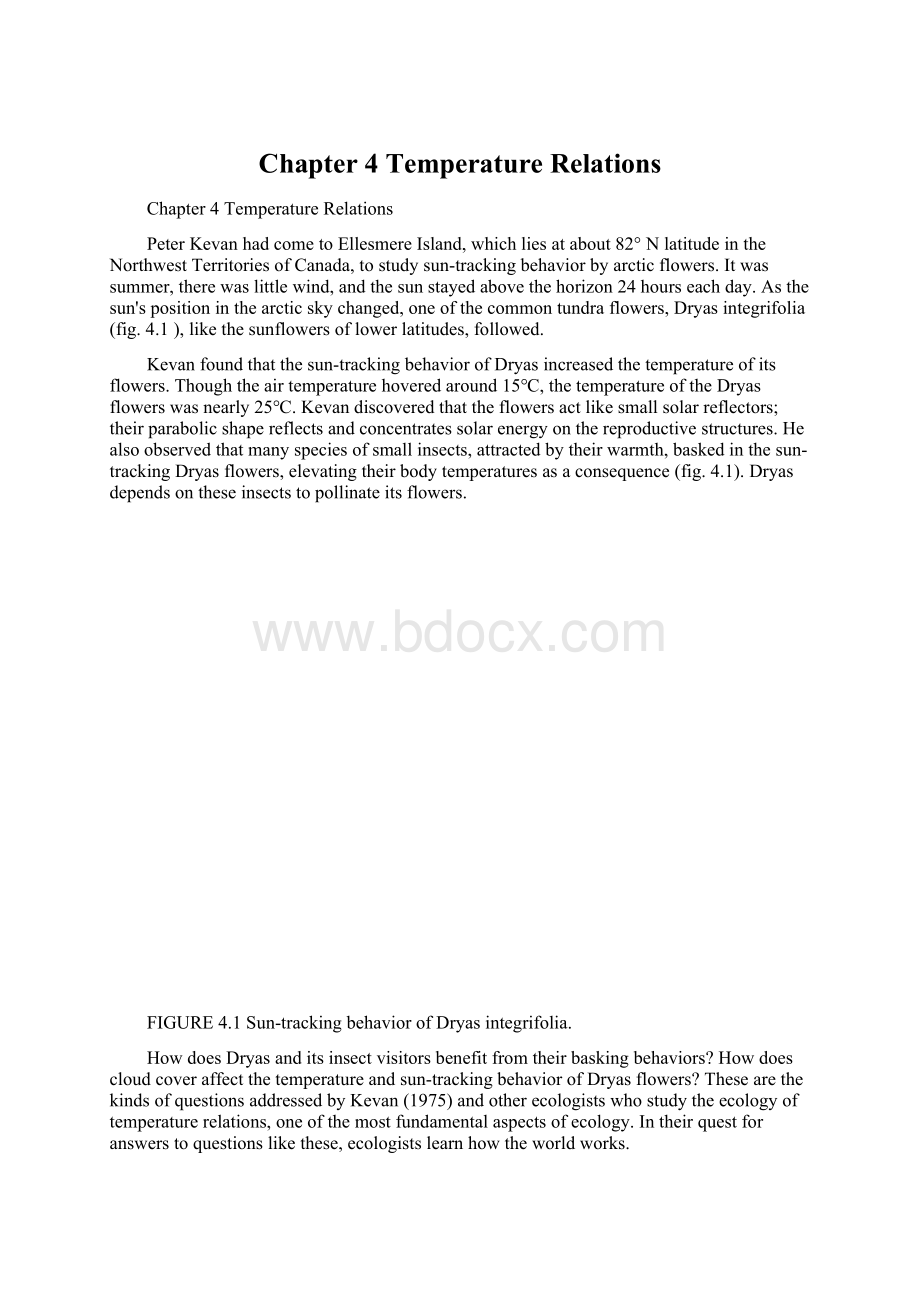Chapter 4TemperatureRelations.docx
《Chapter 4TemperatureRelations.docx》由会员分享,可在线阅读,更多相关《Chapter 4TemperatureRelations.docx(41页珍藏版)》请在冰豆网上搜索。

Chapter4TemperatureRelations
Chapter4TemperatureRelations
PeterKevanhadcometoEllesmereIsland,whichliesatabout82°NlatitudeintheNorthwestTerritoriesofCanada,tostudysun-trackingbehaviorbyarcticflowers.Itwassummer,therewaslittlewind,andthesunstayedabovethehorizon24hourseachday.Asthesun'spositioninthearcticskychanged,oneofthecommontundraflowers,Dryasintegrifolia(fig.4.1),likethesunflowersoflowerlatitudes,followed.
Kevanfoundthatthesun-trackingbehaviorofDryasincreasedthetemperatureofitsflowers.Thoughtheairtemperaturehoveredaround15℃,thetemperatureoftheDryasflowerswasnearly25℃.Kevandiscoveredthattheflowersactlikesmallsolarreflectors;theirparabolicshapereflectsandconcentratessolarenergyonthereproductivestructures.Healsoobservedthatmanyspeciesofsmallinsects,attractedbytheirwarmth,baskedinthesun-trackingDryasflowers,elevatingtheirbodytemperaturesasaconsequence(fig.4.1).Dryasdependsontheseinsectstopollinateitsflowers.
FIGURE4.1Sun-trackingbehaviorofDryasintegrifolia.
HowdoesDryasanditsinsectvisitorsbenefitfromtheirbaskingbehaviors?
Howdoescloudcoveraffectthetemperatureandsun-trackingbehaviorofDryasflowers?
ThesearethekindsofquestionsaddressedbyKevan(1975)andotherecologistswhostudytheecologyoftemperaturerelations,oneofthemostfundamentalaspectsofecology.Intheirquestforanswerstoquestionslikethese,ecologistslearnhowtheworldworks.
Thethermometerwasoneofthefirstquantitativeinstrumentstoappearinthescientifictoolkit,andwehavebeenmeasuringandreportingtemperatureseversince.Humanconcernfortemperatureshowsitselfeverywhere.Localtelevisionreviewsthehighandlowtemperaturesoftheprecedingdayandforecaststemperaturesforthecomingday.Dailynewspapersreporttemperaturesfromnearlyeverycorneroftheglobe.Iftwopeoplefromdifferentregionsmeet,thefirstquestionstheyaskconcerntheweather:
Arethesummersveryhot?
Arethewinterscold?
Wewearourenduranceofextremetemperatureslikebadgesofheroism;yettodaywelistenapprehensivelytotheforecastofasmalltemperaturechange--theprospectofglobalwarming.
WhyisHomosapienssoconcernedwithtemperature?
Forusandallotherspecies,theimpactofextremetemperaturescanrangefromdiscomfort,ataminimum,toextinction.Long-termchangesintemperaturehavesetentireflorasandfaunasmarchingacrosscontinents,somespeciesthriving,someholdingoninsmallrefuges,andothersbecomingextinct.Areasnowsupportingtemperatespecieswereattimestropicalandatothertimesthefrigidhomesofreindeerandwoollymammoths.
Wedefinedecologyasthestudyoftherelationshipsbetweenorganismsandtheirenvironments.Inchapter4.weexaminetherelationshipbetweenindividualorganismsandtemperature,oneofthemostimportantenvironmentalfactorsinthelivesoforganisms.
CONCEPTS
●Macroclimateinteractswiththelocallandscapetoproducemicroclimates.
●Mostspeciesperformbestinafairly'narrowrangeof
temperatures.
●Manyorganismshaveevolvedwaystocompensatefor
variationsinenvironmentaltemperaturebyregulating
bodytemperature.
●Manyorganismssurviveextremetemperaturesby
enteringarestingstage.
CASEHISTORIES:
microclimates
Macroclimateinteractswiththelocallandscapetoproducemicroclimates.
Whatdowemeanbymacroclimateandmicroclimate?
Microclimateiswhatweatherstationsreportandwhatwerepresentedwithclimatediagramsinchapter2.Microclimateisclimaticvariationonascaleofafewkilometers,meters,orevencentimeters,usuallymeasuredovershortperiodsoftime,Youacknowledgemicroclimatewhenyouchoosetostandintheshadeonasummer'sdayorinthesunonawinter'sday.Macroclimateandmicroclimateareusuallysubstantiallydifferent.Becausemanyorganismsliveouttheirlivesinverysmallareasduringperiodsoftimerangingfromdaystoafewmonths,macroclimatemaybelessimportantthanmicroclimate.Microclimateisinfluencedbylandscapefeaturessuchasaltitude,aspect,vegetation,coloroftheground,andpresenceofbouldersandburrows.Thephysicalnatureofwaterreducestemperaturevariationinaquaticenvironments.
Altitude
Aswesawinchapter2(seefig.2.38),temperaturesaregenerallylowerathighelevations.Theseloweraveragetemperaturesareaconsequenceofseveralfactors.First,becauseatmosphericpressuredecreaseswithelevation,airrisingupthesideofamountainexpands.Theenergyofmotion(kineticenergy)requiredtosustainthegreatermovementofairmoleculesintheexpandingairmassisdrawnfromthesurroundings,whichcoolasaresult.Asecondreasonthattemperaturesaregenerallylowerathigherelevationsisthatthereislessatmospheretotrapandradiateheatbacktotheground.
Aspect
Topographicfeaturessuchashills,mountains,andvalleyscreatemicroclimatesthatwouldnotoccurinaflatlandscape.Mountainsandhillsidescreatethesemicroclimatesbyshadingpartsoftheland.IntheNorthernHemisphere,theshadedareasareonthenorth-facingsides,ornorthernaspects,ofhills,mountains,andvalleys,whichfaceawayfromtheequator.IntheSouthernHemisphere,thesouthernaspectfacesawayfromtheequator.
Youcanseetheeffectofaspect,inminiature,aroundbuildings.Ifyouwanttowarmyourselfonasunnywinter'sdayintheNorthernHemisphere,yougotothesouthsideofabuilding,toitssouthernaspect,whichfacestheequator.IntheSouthernHemisphere,youwouldgenerallyfindthewarmestspotonthenorthsideofabuilding.Similarly,thenorthernandsouthernaspectsofmountainsandvalleysofferorganismscontrastingmicroclimates.Themicroclimatesofnorth-andsouth-facingaspectsofhillsidesmaysupportverydifferenttypesofvegetation(fig.4.2).
FIGURE4.2Vegetationonnorth-andsouth-facingslopes.
Vegetation
Becausetheyalsoshadethelandscape,plantscreatemicroclimates.Forinstance,trees,shrubs,andplantlitter(fallenleaves,twigs,andbranches)produceecologicallyimportantmicroclimatesindeserts.Thedesertlandscape,whichoftenconsistsofamosaicofvegetationandbareground,isalsoapatchworkofsharplycontrastingthermalenvironments.SuchapatchworkisapparentnearKemmerer,Wyoming,acolddesertmuchliketheGobiinMongolia(seefig.2.19).LiketheGobi,Kemmerercanbebitterlycoldinwinterandblisteringinsummer.Onesummer'sdayRobertParmenterandhiscolleagues(1989)measuredthetemperaturesinvariouspartsoftheKemmererlandscape.Parmenterfoundthatwhilethetemperatureonbaresoilsoaredto48℃,afewmetersawayinplantlitterunderatallshrubthetemperaturewasamoderate21℃(fig.4.3).Meanwhile,temperaturesunderlowshrubswithlessleafareawereabitwarmerbutstillnotashotassoilintheopen.Asmallorganisminthislandscapecouldchoosemicroclimatesdifferingintemperatureby27℃.
FIGURE4.3Desertshrubsandmicroclimate(datafromParmenter,Parameter,andCheney1989).
ColoroftheGround
Anotherfactorthatcansignificantlyaffecttemperaturesisthecoloroftheground.Thisstatementmaysoundabitoddifyouarefromamoistclimate,eithertemperateortropical,wherevegetationusuallycoverstheground.But,aswehavejustseen,muchofthearidorsemiaridlandscapeisbareground,whichcanvarywidelyincolor.Colorshavebeenusedtonamedesertsaroundtheworld,suchasthecentralAsiandesertscalledKaraKum,whichmeansblacksandinTurkish.andKyzylKum,orredsand,andWhiteSands,NewMexico(fig.4.4).
FIGURE4.4Whiteandblacksands.
Baregroundisthedominantenvironmentofferedbybeaches.NeilHadleyandhiscolleagues(1992)studiedthebeachesofNewZealand,whichrangeincolorfromwhitetoblackandofferawiderangeofmicroclimatestobeachorganisms.Thesebeachesheatupunderthesummersun,butblackbeachesheatupfasterandtohighertemperatures.Theblackbeachesheatupmorebecausetheyabsorbmorevisiblelightthandothewhitebeaches(fig.4.5).Whenairtemperaturesatbothbeacheshoveredaround30℃,Hadleyandhiscolleaguesfoundthatthetemperatureofthesandonthewhitebeachaveragedaround45℃.Incontrast,theymeasuredsandtemperaturesontheblackbeachashighas65℃.Thoughthesewhiteandblackbeachesareexposedtonearlyidenticalmacroclimates,theyhaveradicallydifferentmicroclimates.
FIGURE4.5Colorofthegroundandtemperature(datafromHadley,Savill.andSchultz1992).
PresenceofBouldersandBurrows
Manychildrensoondiscoverthattheundersidesofstonesharborahostoforganismsseldomseenintheopen.Thisispartlybecausethestonescreatedistinctivemicroclimates.E.B.Edney'sstudies(1953)oftheseashoreisopodLigiaoceanicadocumentedtheeffectofstonesonmicroclimate.Edneyfoundthatoverthespaceofafewcentimeters,Ligiacouldchooseairtemperaturesrangingfrom20℃intheopento30℃intheairspacesunderstones,whichheatedtobetween34°and38℃.Thissmall-scalevariationintemperatureissummarizedinfigure4.6.
FIGURE4.6Microclimatesunderstones(datafromEdney1953).
Animalburrowsalsohavetheirownmicroclimates,inwhichtemperaturesareusuallymoremoderatethanatthesoilsurface.Forexample,whiledailytemperaturesunderashrubintheChihuahuanDesertrangedfrom17.5°to32℃,temperaturesinanearbymammalburrowrangedfrom26~to28℃.Thisburrowwascoolerthanthesurfaceduringthedayandwarmeratnight.Whatdothesedatasuggestaboutthemicroclimatesexperiencedbyplantroots,soilbacteria,andburro